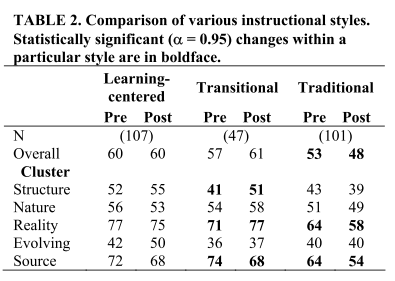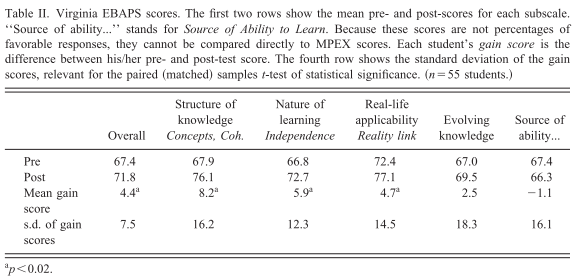Developed by Andrew Elby, John Frederiksen, Christina Schwarz, and Barbara White
| Purpose | To probe the epistemological stances of students in introductory physics, chemistry and physical science. |
|---|---|
| Format | Pre/post, Multiple-choice, Agree/disagree |
| Duration | 15-22 min |
| Focus | Beliefs / Attitudes (epistemological beliefs, structure of knowledge, nature of knowing and learning, real-life applicability, evolving knowledge, source of ability to learn) |
| Level | Intro college, High school |
Sample questions from the EBAPS:
DIRECTIONS: For each of the following items, please read the statement, and indicate (on the scantron answer sheet) the answer that describes how strongly you agree or disagree.
A: Strongly disagree B: Somewhat disagree C: Neutral D: Somewhat agree E: Strongly agree
Tamara just read something in her science textbook that seems to disagree with her own experiences. But to learn science well, Tamara shouldn't think about her own experiences; she should just focus on what the book says.
DIRECTIONS: In each of the following items, you will read a short discussion between two students who disagree about some issue. Then you'll indicate whether you agree with one student or the other
Brandon: A good science textbook should show how the material in one chapter relates to the material in other chapters. It shouldn't treat each topic as a separate "unit," because they're not really separate.
Jamal: But most of the time, each chapter is about a different topic, and those different topics don't always have much to do with each other. The textbook should keep everything separate, instead of blending it all together.
With whom do you agree? Read all the choices before circling one.
(a) I agree almost entirely with Brandon.
(b) Although I agree more with Brandon, I think Jamal makes some good points.
(c) I agree (or disagree) equally with Jamal and Brandon.
(d) Although I agree more with Jamal, I think Brandon makes some good points.
(e) I agree almost entirely with Jamal.
The developer has an online paper describing The Idea Behind the EBAPS.
more details
This is the second highest level of research validation, corresponding to at least 5 of the validation categories below.
Research Validation Summary
Based on Research Into:
- Student thinking
Studied Using:
- Student interviews
- Expert review
- Appropriate statistical analysis
Research Conducted:
- At multiple institutions
- By multiple research groups
- Peer-reviewed publication
The EBPAS questions were developed based on an extensive literature review of other epistemological surveys. The developers synthesized other researchers ideas to create guiding principles, which they used to write the EBAPS questions. The EBAPS was given to pilot subjects, and about 100 community college students who answered the survey and provided their reasoning for each question. The questions were subsequently revised. The reliability of the EBAPS categories was calculated, and results were acceptable in four of five categories. The EBAPS has been given to over 1000 students in high school and introductory university physics courses at multiple-institutions the results published in over eight peer-reviewed publications.
References
- S. Bonham, Reliability, compliance, and security in web-based course assessments, Phys. Rev. ST Phys. Educ. Res. 4 (1), 010106 (2008).
- E. Close, Teacher Characteristics and Student Learning in Secondary Science, Seattle Pacific University, 2009.
- G. Duffy, S. Chance, and B. Bowe, Improving Engineering Students’ Design Skills in a Project-Based Learning Course by Addressing Epistemological Issues, presented at the 40th SEFI Conference, Thessaloniki, Greece, 2012.
- A. Elby, Getting Started with Research on Epistemologies and Expectations, in Getting Started in PER, edited by C. Henderson and K. Harper, (American Association of Physics Teachers, College Park, 2010), Vol. 2.
- A. Elby, Helping physics students learn how to learn, Am. J. Phys. 69 (S1), S54 (2001).
- K. Johnson and S. Willoughby, Epistemic belief structures within introductory astronomy, Phys. Rev. Phys. Educ. Res. 14 (1), 010135 (2018).
- K. Johnson and S. Willoughby, Changing epistemological beliefs with nature of science implementations, Phys. Rev. Phys. Educ. Res. 14 (1), 010110 (2018).
- J. Marx, S. Mian, and V. Pagonis, Attitudes of Undergraduate General Science Students Toward Learning Science and the Nature of Science, presented at the Physics Education Research Conference 2004, Sacramento, California, 2004.
- K. Muis and B. Gierus, Beliefs About Knowledge, Knowing, and Learning: Differences Across Knowledge Types in Physics, J. Exp. Educ. 82 (3), 408 (2013).
- A. Warren, Impact of Bayesian updating activities on student epistemologies, Phys. Rev. Phys. Educ. Res. 16 (1), 010101 (2020).
- A. Warren, Quantitative critical thinking: Student activities using Bayesian updating, Am. J. Phys. 86 (5), 368 (2018).
- D. Zeidler, B. Herman, M. Ruzek, A. Linder, and S. Lin, Cross-cultural epistemological orientations to socioscientific issues, J. Res. Sci. Teaching 50 (3), 251 (2013).
We don't have any translations of this assessment yet.
If you know of a translation that we don't have yet, or if you would like to translate this assessment, please contact us!
Download the EBAPS answer key.
Download the EBAPS scoring tool.
| Typical Results |
|---|
Typical scores on the EBAPS for different teaching methods from Marx et al. 2004. Traditional courses had little or no research-based pedagogy. Class time is largely filled with lectures and Transitional courses had approximately half of the classroom time devoted to research-based activities. These activities come in several forms including exploratory laboratories, activities modeled after Interactive Lecture Demonstrations, and group worksheets designed to reinforce relevant physical concepts and build numeracy. The other half of the time is lecture-based. Learning-centered courses incorporated research- based curricular materials of the kind discussed above in every class meeting, and lecture time is minimized. Each course had traditionally-graded assignments,including several homework sets, quizzes, tests, projects, and a final exam. None of the graded assignments were intended to foster or reinforce students’ epistemologies.
Typical results for high school students from Elby 2001:
|
The latest version of the EBAPS, released in 2006, is version 5.0.






